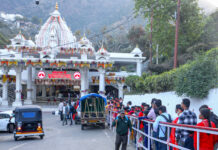 Stunning hilltop forts & glorious palaces
Stunning hilltop forts & glorious palaces
Jaipur, the City of Victory, is chaotic and congested, though it still has a habit of tickling travelers pink. Stunning hilltop forts and glorious palaces fit like footprints from a rich royal past, candyfloss-bright turbans blaze a trail through brilliant bargain-filled bazaars, and fluttering saris catch the eye like butterflies.
As the gateway to the desert state of Rajasthan, however, it’s also a city permanently under siege. Package tourists are captivated by (and offloaded on) the bustling bazaars, world-class hotels and clammy sophistication, while camel carts and cows waddle through diesel-soaked streets, rampaging rickshaw drivers hustle and burn past businessmen and tourists, and scores of street children beg outside huge jewellery shops and palatial hotels.
Jaipur beams boldest at dusk – when it’s well worth walking to Amber – and, much like its founder, Jai Singh II, the Pink City is both proud and resilient.
Tourist attractions
Hawa Mahal: Hawa Mahal of Jaipur is an example of the architectural magnificence prevalent in that period. Hawa Mahal is the signature building of Jaipur. A must in any Jaipur sightseeing trip.
City Palace of Jaipur: City Palace of Jaipur is a combination of Rajasthani and Mughal architecture. It is spread into a vast area and holds many palaces, gardens, forts, museums and temples in it.
Jantar Mantar: Jantar Mantar was conceived as a quest for discovering the cosmos. The aim was to verify astronomical observations and to generate interest among public about astronomy.
Amber Palace: Amber Palace is a magnificent building built to rival the Mughal grandeur. It is a significant symbol of the rich Rajput architecture.
Fairs and Festivals:
Jaipur is the land of fairs and festivals. The Pink City remains soaked with the splendor of colors. Every fair and festival has its own significance.
Teej festival:
Teej festival is well known across the world and is an icon of Jaipur tourism. It is celebrated to welcome the monsoon during Shraavan month (July-August) as per Hindu calendar. Millions of devotees participate in the auspicious rally of Teej Mata, said to be an incarnation of Goddess Parvati. This two-day long festival is celebrated on the 3rd and 4th day of Shukla Paksha (bright fortnight) of Shravan month.
Bright fortnight symbolizes “growth” hence the women of Rajasthan keep fast for the long life of their husbands while the men offer prayers to Teej Mata for good rain and crop. Hindu mythological significance of this festival is that after a long separation, Goddess Parvati reunited with her husband Lord Shiva. She gave a boon to this day that whoever does worship of Goddess Parvati on this day, she fulfills his/her wishes.
Parents of married women send “Sinjara” to their daughters on the day before Teej. Sinjara is a gift package which includes make-up stuff symbolizing her Suhaag (coverture), i.e. bindi, vermilion, mehendi or henna, bangles; Ghevar (a special disc shaped sweet), and Lahariya (a multi-color sari with zigzag pattern).
After receiving those gifts from the parents home, a married lady decorates herself with henna, various ornaments, wears Lahariya sari and enjoys Teej fair with her husband, in-laws and relatives.
In Teej fair, an auspicious rally of Teej Mata starts from Tripolia Gate of Jaipur which passes through various main markets and ends at Chaugan Stadium. Members of royal family decorate the idol of Teej Mata for this auspicious rally.
Accouterment (Lawajma) of decorated elephants, horses and camels walk before Teej Mata’s Palki (palanquin) which is made of gold and silver. Various folk dances and folk arts are performed during this rally.
Gangaur Festival: Gangaur festival starts in Jaipur on Tritiya tithi (3rd day) of Krishna paksha (waning moon) of Chaitra month (March-April) and ends on Tritiya tithi (3rd day) of Shukla paksha (waxing moon) of Chaitra month. Hence, Gangaur festival is celebrated in Jaipur for 16 days. “Gangaur” is the combination of two words “Gana” and “Gaur”. “Gana” stands for Lord Shiva, and “Gaur” is the synonym of goddess “Gauri” or “Parvati”. In Rajasthan, married women worship goddess Gauri for long life and good health for their husbands while unmarried women worship her for being blessed good husband.
Married women and unmarried girls collect water everyday from different sacred places or temples to offer ablution to Gangaur. They decorate their Kalash (water pots) with traditional Rajasthani Maandna (special type of painting done by lime water). They also collect grass leaves and flowers for worship of Gangaur. During water collection and flower collection, they sing Rajasthani folk songs related to Gangaur festival.
One of the most popular songs is “Bazaraan mein jaata hi Isar ramad gayo, mhaane melo to dikha de gangaur Isar Choto So…” It means that young Isar presses Gauri in the market to see the Fair (Mela) and wants lot of articles purchased for him. Though Gangaur festival is observed in many parts of Rajasthan, the Jaipur Gangaur festival is world famous.
After collecting water, grass leaves and flowers; they worship Gangaur with grass leaves and sing a specific Rajasthani folk song “Gaur Gaur Ganpati, Isar Pooje Parvati” which means goddess Parvati worships Lord Shiva (Isar) to marry him.
How to reach:
Air: Indian Airlines connects Jaipur with Delhi, Jodhpur, Udaipur, Aurangabad, Bombay, Varanasi, Calcutta, Ahmedabad.
Rail: Jaipur is connected by rail with Delhi, Agra, Ahmedabad, Ajmer, Abu Road (Mount Abu), Udaipur, Bombay and Sawai Madhopur.
Road: Good motorable roads connect Jaipur with Delhi 258 km, Agra 236 km, Bikaner 321 km, Udaipur 405 km, Ajmer 131 km, Jodhpur 316 km, Bharatpur 176 km, Jaisalmer 638 km and Bombay 1202 km
Bus: Regular buses ply from Jaipur to the above places and Alwar, Kota, Sariska, Mathura, Indore, Chittorgarh and Barmer.






